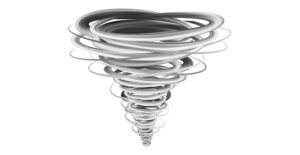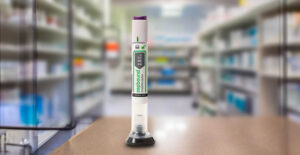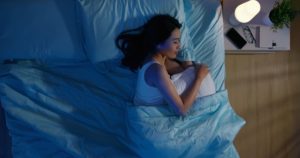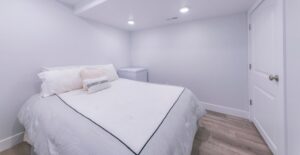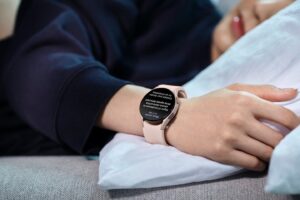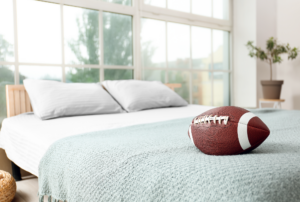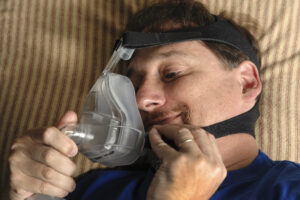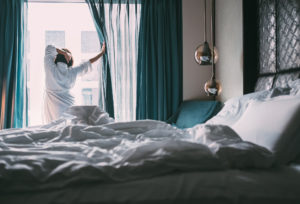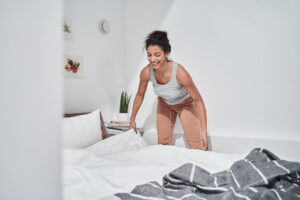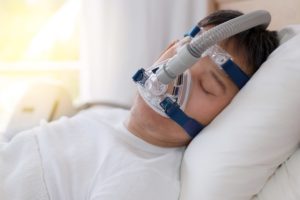How Does Your Sleep Change With a New Mattress?
Sleeping on the right mattress can often make the difference between getting a good or bad night’s sleep. A good mattress can help relieve pressure points, align the spine, and regulate body temperature – all helping you sleep through the night and wake up pain-free and ready to start your day. On the converse, sleeping on the wrong mattress can lead to pain and discomfort, poor temperature regulation, and overall restless and non-restorative sleep.
I’m a busy mom with a hectic schedule so sleep is a precious commodity. On a typical night I get about six hours of sleep. I know I should get more, but I’m a night owl and appreciate the peace and quiet in the house after everyone else is in bed. I attempt to make up for my sleep debt by getting a few more hours of shut-eye on the weekends, but that can make waking up Monday morning extra tough.
Given my less-than-ideal sleep schedule, I try to maximize the rest of my sleep hygiene. Our room is nice and dark. We keep it a cool 64 degrees at night, and I stay off my phone once I hit the bedroom.
But there was one major factor that I’d been ignoring. The truth is that even though I’m well aware of the potential benefits of a good mattress, my husband and I had been sleeping on the same all-foam model for more than a decade, well past its recommended lifespan.
Our old mattress’s layers of foam, already soft to start with, had deteriorated so much that they offered little in the way of support. And as a side sleeper who naturally moves a lot throughout the night, I was waking up feeling like I’d been stuck in the same position for hours. My arm would have that pins and needles feeling, and my back and neck felt stiff.
It was definitely time for a change, and the perfect opportunity to try an experiment: Would sleeping on a high-quality mattress actually make a difference for my sleep health?
Week One: First Impressions
When my new WinkBed arrived I was very excited to get it unboxed right away so that it’d be ready to sleep on that night. The WinkBed is one of the highest rated models among those tested by the Test Lab, and I had high expectations.
Right off, my first impressions were very positive. Set up was easy, there was little-to-no noticeable off-gassing odor, and the cover was soft to the touch. By bedtime, the mattress had fully expanded from its compressed shipping shape and was ready for use.
I eagerly climbed in, ready to drift off, but the feel of the WinkBed was so different from my old mattress that it took me a while to relax. I tossed and turned for a bit, not used to the increased supportiveness from the coil core or the firmer foams in the comfort layers.
I was pleasantly surprised, though, when I checked my sleep tracker the next morning. Before I started to sleep on the WinkBed, I collected several weeks worth of sleep data using a Whoop health and fitness wearable. That way I could objectively compare my sleep on my old mattress to my sleep on the new one.
According to my Whoop, even though I’d gotten about an hour less sleep than usual, my percentage of restorative sleep was higher by almost eight points! Restorative sleep is the kind that helps you wake up feeling refreshed and ready for the day. Whoop recommends that between 40 and 50 percent of your overall sleep should be restorative.
Prior to getting my new mattress, I’d been averaging about 25 percent each night which is obviously not optimal. But by the end of the week, my average restorative sleep was just over 29 percent, and I was already noticing a difference in the way I felt in the morning even though I was getting about the same amount of sleep.
Plus I was experiencing relief from some minor aches and pains in my neck and shoulders that I hadn’t even fully realized were keeping me from feeling my best.
Week Two: Already Seeing Results
At the end of two weeks I was still impressed by the WinkBed and so was my husband.
A lot of the sleep improvements we were experiencing seemed to be linked to the way the WinkBed better supported our preferred sleep positions. The upper foam layers of the WinkBed provided enough contour to compliment my side sleeping while the underlying zoned coils offered just-right levels of uplift, especially through the hips and torso, to keep my combination-sleeper husband feeling supported as he changed positions.
It also felt easier to fall asleep and stay asleep. On our old bed, the super-soft foam layers made it seem like we were sleeping “in” the mattress rather than on it. This made even minor adjustments to our sleep positions challenging.
The WinkBed, by contrast, offered excellent ease of movement. My husband could shift and adjust easily as he settled into sleep, and I could tell the new mattress was much more conducive to my active sleeping style, allowing me to move as needed throughout the night. The result was a more relaxed and rested feeling come morning even if the overall time sleeping remained mostly unchanged.
Week Three: Big Spike in Sleep Quality
As I noted, prior to sleeping on my new WinkBed, I wore a Whoop sleep tracker for five weeks so I had a good sense of what my sleep was like on my old mattress. I’d continued tracking my sleep on the WinkBed and logging into the app each morning to see my numbers for the night. When week three rolled around I wanted to do a quick check of the data overall, just to see how things were going.
I was once again impressed with my restorative sleep numbers. Like I said above, Whoop suggests that between 40 and 50 percent of your overall sleep should be restorative. I had only hit that threshold twice since getting my WinkBed. But I was seeing a threefold increase in the number of nights I was at or above 35 percent which was a pleasant surprise.
More importantly, I seemed to be feeling the effects of better sleep. I was waking up less tense, more comfortable, and with the sense that I’d slept longer and better than the numbers reflected on my tracker.
Week Four: Getting More REM Sleep
After a solid month sleeping on the WinkBed Hybrid Mattress it was obvious that it was far superior to my old mattress across sleep categories. Part of that had to do with the age of my old mattress, but part of it was due to the WinkBed’s quality materials and construction.
I was moving easier and sleeping cooler thanks to the WinkBed’s heat-wicking responsive foams and individually pocketed springs. I was also happy with the WinkBed’s excellent pressure relief, something I thought I might have to sacrifice switching from our old all-foam model. Both of these factors meant I was waking up less during the night because I was uncomfortable or too hot.
The data was positive too. My REM sleep increased by six percent and my deep sleep increased by almost 20 percent, both of which contribute to overall sleep quality. My sleep consistency, or how uniform my sleep was every night, also increased from a score of 61 out of 100 to a 72. There’s a positive connection between sleep consistency and better sleep overall, so I was happy to see this upward trajectory.
My Final Thoughts
Upgrading to the WinkBed Hybrid Mattress made a positive difference in my sleep. My Whoop sleep tracker made this objectively clear as the data showed increases in key sleep factors including sleep consistency and effectiveness. And just as importantly, I was feeling better in the mornings.
My life is still chaotic, and I still stay up too late. But now I have a mattress that is helping to maximize the time I do spend asleep. I wake up feeling better rested, a little less groggy, and a little more ready to face the day. Starting off the morning feeling calmer, fresher, and less grumpy is a win for this night owl.
And now I’m actually looking forward to sleeping on my mattress. My old mattress was just something between me and the bed frame. The WinkBed is more comfortable and supportive so it’s actually nice to sink into at the end of a long day. That makes an earlier bedtime a lot more enticing.
Overall, this experiment was both validating and enlightening. My experience showed the high scores the WinkBed received during our in-lab testing were demonstrably accurate, and I came to realize on a personal level how a thoughtfully designed mattress can positively impact your sleep.
If you’re experiencing sleep difficulties or just have a busy life, you might consider a new mattress. Quality sleep is important. Don’t underestimate the role your mattress plays in getting more and better rest.




